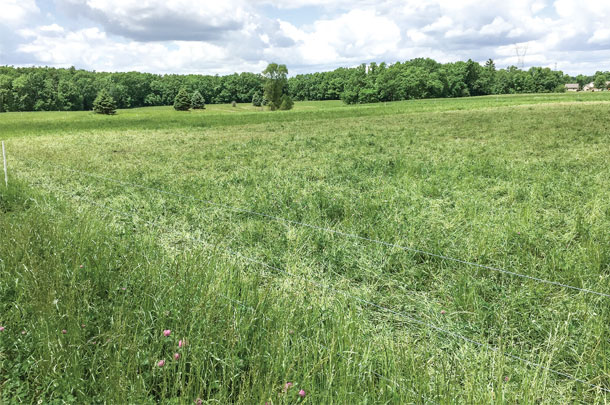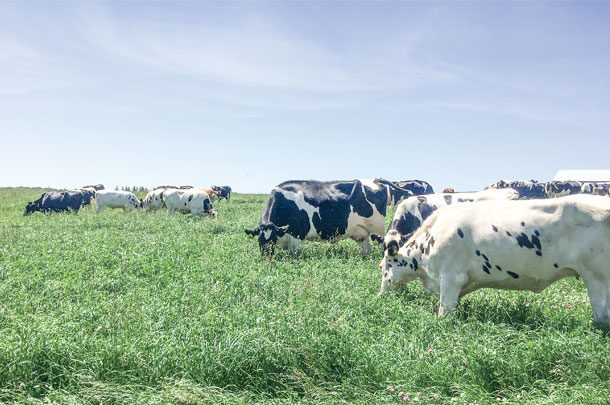Unfortunately, in today’s dairy economy, more and more farms are changing their practices in an effort to decrease operational expenses out of desperation.
But perhaps there is an option that can both inspire change and make needed financial adjustments.
Heifer development is the second- largest expenditure on a dairy. By grazing under intense management, this cost has potential to be dramatically decreased.
Possible areas of improvement
According to the Natural Resources Conservation Service (NRCS), around 57% of expenses associated with heifer raising are attributed to feed. Costs of labor, machinery, fuel and chemicals, along with transportation and storage costs, all contribute to the making of feed.
Grazing allows for decrease, or even elimination, of many of these factors.
“In a grazing system, the animal does the harvesting, which is a much lower cost system than mechanized,” says Denis Turner, owner of Turner’s Heifer Haven, a custom heifer grazing operation in Missouri.
The act of grazing removes the need for machinery to harvest and trucks to transport, along with fuel. Further, less labor hours must be committed to field work.
Grazing also allows for reduced crop establishment and chemical application expenses, as the forages are perennial and manure and hoof disturbance in the field reduces the need for tillage, soil additives and fertilizer.
“With well-managed grazing, we see improvements in soil cultivation, organic matter and productivity of pasture,” says Ted Probert, a dairy field specialist with the University of Missouri Extension.

Heifer health also is improved through well-managed grazing systems. Grazed animals get more exercise, are cleaner, have less feet and leg issues and are less stressed than those in confinement systems.
“The important thing is the development of the animal and that the animal is able to freshen at the right age in life and be healthy,” Turner says.
The health benefits of grazing also manifest in improved growth and production performance.
According to the University of Wisconsin, pasture-raised replacements have an average daily gain (ADG) of 1.97 pounds per day – whereas industry development goals are 1.7 pounds per day and on average confined heifers gain 1.86 pounds per day.
First-lactation performance in confined heifers averages 23,415 pounds per head. Markedly, pasture- raised heifers average 25,328 pounds per head. Translated, grazed heifers produce 1,900 pounds or 7.5% more than conventionally raised heifers.
This advantage in performance renders increased revenue. At $15 per hundredweight, the 1,900-pound advantage would increase revenue by $285 per cow.
“People forget that this is production agriculture. There is no production loss. It is still managed just as intensively. We are just letting the cattle do the harvesting instead of equipment,” says Adam Abel, a grazing advocate and soil conservationist with the NRCS.
Comparing systems
Typically, heifers are fed in one of two systems, either onsite confinement or custom confinement.
According to the USDA, year-round on-site confinement costs an average of $548-$730 per head per year, or $1.50-$2.50 per head per day. Year-round custom confinement averages $730-$913 per head per year, or $2-$2.50 per head per day.
Alternatively, grazing systems allow for 180 days (which can vary by region of grazing), while the remainder of the year is spent in confinement.
Grazing averages $0.43 per head per day, or $77 per 180 days. With the added on-site confinement, at $1.50 per head per day, or $278 per head per 185 days, the combined cost per head per year is $355.
For comparison, converting from year-round confinement reduces heifer development costs per 100 head by 35%, or $19,300. Converting from custom confinement produces a 51% reduction.
Too good to be true?
“Grazing can help to reduce cost and maintain performance, but you cannot just kick them out into a field and call that grazing. You have to have a system in place and approach it in a systematic manner for it to work,” Turner says.
Successful grazing is much more than just letting heifers out on pasture. Attention must be paid to stocking rate, intake and pasture utilization. Animals are generally rotated to different pasture every one to two days.
“The best way to manage stand density and grass height is rotational grazing. The best graziers get great results when moving heifers daily to a new section of pasture,” says Matt Bomgardner, an education coordinator for the Dairy Grazing Apprenticeship and owner and operator of Blue Mountain View Farm in Pennsylvania.
Bomgardner also notes that there are costs to establishing good pasture, explaining that it is important to consider time and labor requirements to rotate animals and determining cost of establishing or improving pasture ground.
Many dairies may question if it is economically feasible to convert crop acres to pasture.
According to Abel, “It is straight up feasible to convert crop acres, including corn, to managed grazing.”
This conversion of land and change to day-to-day confinement chores, such as feeding and mixing total mix rations (TMRs), often faces criticism from conventional farmers. Many producers see grazing as a low production system where they lose the control that comes with confinement, or see it as old-fashioned, like how their grandparents farmed.
“It is a learning curve and you have to be comfortable with what you are going to do. There are hurdles to be jumped and dedication and effort to make it work,” says Turner.
For dairy producers, finding ways to decrease expenses and increase revenue is an inspired, but also desperate task, sometimes a final effort to save their farms. For some, raising replacement heifers on pasture may be a viable option.
Grazing is no longer letting the cows out like Grandpa did. It is a highly intensive, productive option that can reduce heifer-raising expenses dramatically and yield more productive, healthier replacements. ![]()
PHOTO 1: Grazing can reduce heifer development costs by 35% to 50% compared to confinement raising systems.
PHOTO 2: Well-managed grazing can lead to increased organic matter and microorganisms in the soil, improving pasture productivity. Photos provided by Adam Abel.
Madison Anderson is a 2019 Progressive Forage intern.











